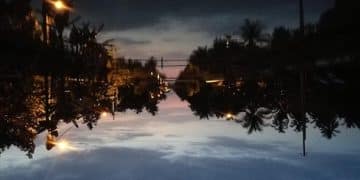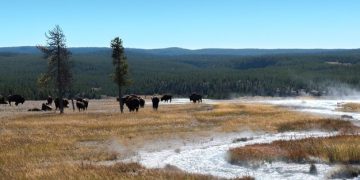Bioluminescence in the US: Witness Nature’s Magical Light Show
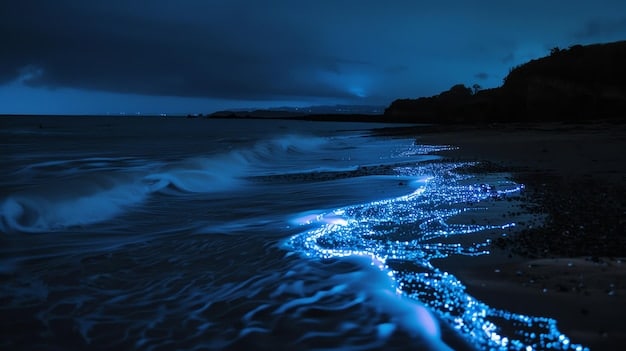
Unveiling the Secrets of Bioluminescence: A Guide to Witnessing Nature’s Light Show in the US explores this captivating natural phenomenon, offering insights into its causes, best viewing locations across the United States, and tips for respectful observation, aiming to connect readers with the wonder of bioluminescent displays.
Prepare to be amazed by nature’s own light show! Unveiling the Secrets of Bioluminescence: A Guide to Witnessing Nature’s Light Show in the US will take you on a journey to discover the incredible world of living light, where organisms create their own mesmerizing glow.
What is Bioluminescence?
Bioluminescence, simply put, is the production and emission of light by a living organism. This fascinating phenomenon occurs when a chemical reaction within the organism creates light, often a blue-green hue. It’s a natural wonder found in various marine and terrestrial creatures.
But how does it work? The most common type of bioluminescence involves a chemical called luciferin and an enzyme called luciferase. When luciferin reacts with oxygen, catalyzed by luciferase, light is produced. The exact chemical pathway varies depending on the species, resulting in different colors and intensities of light.
The Science Behind the Glow
The magic of bioluminescence lies in the intricate chemical processes within the organisms. Understanding these processes helps us appreciate the complexity and beauty of nature’s light displays.
Why do Organisms Bioluminesce?
Bioluminescence serves a variety of purposes for different species. These purposes are all essential for the organisms’ survival in their environments. Here are a few of the primary reasons:
- Defense: Some creatures use bioluminescence to startle predators or to create a diversion, allowing them to escape.
- Attraction: Many marine animals use bioluminescent light to attract mates or lure prey.
- Communication: Bioluminescence can also be used for communication within a species, especially in the deep sea where other forms of communication are limited.
- Camouflage: In some cases, bioluminescence helps organisms blend in with the surrounding environment, camouflaging them from predators or prey.
In conclusion, bioluminescence is a captivating natural phenomenon driven by chemical reactions, which serves diverse purposes for organisms, from defense and attraction to communication and camouflage enhancing their survival in their respective ecological niches.
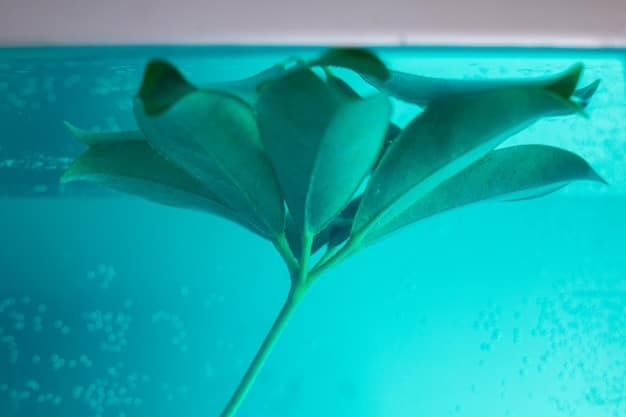
Where to Find Bioluminescence in the US: Coastal Hotspots
The United States boasts several stunning locations where you can witness the spectacle of bioluminescence. Coastal areas are prime viewing spots, where bioluminescent organisms thrive in the marine environment.
Bioluminescence is more prevalent in warmer waters, meaning you will find more locations available down south. Here are some of the best locations that the US has to offer:
Indian River Lagoon, Florida
Located on the east coast of Florida, the Indian River Lagoon is famous for its bioluminescent dinoflagellates. The best time to see the glowing waters is during the warmer months, particularly from May to September. Kayak tours are a popular way to explore the lagoon at night and experience the bioluminescence up close.
Mosquito Bay, Puerto Rico
Mosquito Bay, also known as Bioluminescent Bay, is one of the brightest bioluminescent bays in the world. Its high concentration of dinoflagellates makes the water glow incredibly brightly. Kayaking or boat tours are available, allowing you to witness this mesmerizing phenomenon.
Tomales Bay, California
Tomales Bay, north of San Francisco, also experiences bioluminescent blooms. While not as consistent as some other locations, when the conditions are right, the bay sparkles with bioluminescence. Check local reports and tide charts to increase your chances of seeing the glow.
- Plan Your Visit: Check local weather and tide conditions before heading out. Bioluminescence is often more visible on dark nights with little to no moonlight.
- Respect the Environment: Avoid using flashlights or disturbing the water unnecessarily, as this can disrupt the organisms.
- Book a Tour: Consider joining a guided tour for the best experience. Local guides can provide valuable insights into the phenomenon and ensure a safe and responsible viewing experience.
In conclusion, the hotspots in the US for bioluminescence offer amazing displays. You can find areas from Florida to California that offer a wide variety of options for viewing this marvel.
Optimal Timing: When to See Bioluminescence
Timing is crucial when it comes to witnessing bioluminescence. Certain factors, such as the lunar cycle and seasonal changes, can significantly impact the visibility of the phenomenon.
To help increase the chances of seeing the bioluminescence, here are some of the best times to go:
Lunar Cycle
The lunar cycle is a significant factor in determining the visibility of bioluminescence. Bioluminescence is best observed during the new moon phase when the sky is darkest. The absence of moonlight allows the subtle glow of bioluminescent organisms to stand out more vividly. Plan your visit around the new moon for the best viewing experience.
Seasonal Changes
Seasonal changes also influence the occurrence of bioluminescence. In many coastal regions, bioluminescent blooms are more common during the warmer months. Higher water temperatures and increased nutrient availability can promote the growth of dinoflagellates and other bioluminescent organisms. Check local reports to find out when bioluminescence is most likely to occur in your desired location.
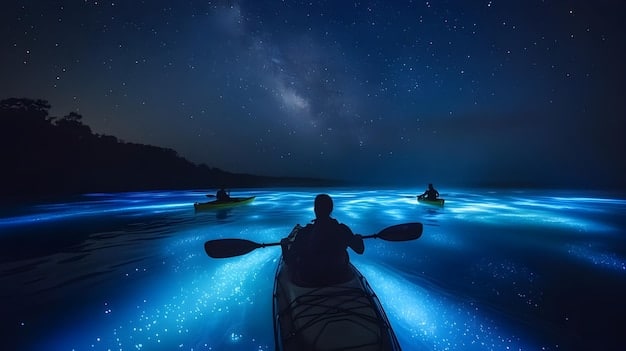
Tidal Conditions
Tidal conditions can also play a role in the visibility of bioluminescence. In some areas, bioluminescence is more visible during low tide when the organisms are concentrated closer to the shore. Check tide charts for your chosen location and plan your visit accordingly.
- Check Local Reports: Local environmental agencies and tour operators often provide updates on bioluminescence activity. Take advantage of these resources to stay informed about the best viewing times.
- Go on a Dark Night: The darker the sky, the better the chance of seeing bioluminescence. Avoid nights with a full moon or excessive light pollution.
- Consider a Winter Viewing: Some locations showcase the marvel more frequently between December and January because of the cool wave action mixing up the glowing organisms.
In conclusion, understanding the lunar cycle, seasonal changes, and tidal conditions is essential for optimizing your chances of witnessing the mesmerizing display of bioluminescence. By planning your visit accordingly, you can increase your likelihood of experiencing this awe-inspiring natural phenomenon.
Respectful Observation: Guidelines for Responsible Viewing
When witnessing bioluminescence, it’s important to practice responsible viewing habits to minimize disturbance to the environment and bioluminescent organisms. Here are some guidelines to follow:
Respectful observation not only keeps nature in its best condition but also promotes a more intimate viewing.
Avoid Artificial Light
Artificial light can disrupt the natural behavior of bioluminescent organisms and diminish the visibility of the phenomenon. Avoid using flashlights or smartphone screens near the water, as this can interfere with your night vision and disturb the bioluminescence. If you need light for navigation, use a red-filtered flashlight, which has less impact on the organisms.
Minimize Disturbance
Minimize disturbance to the water and surrounding environment. Avoid stirring up sediment or creating excessive noise, as this can disrupt the organisms and reduce their bioluminescence. If you’re kayaking or boating, paddle gently and avoid dragging your equipment through the water.
Leave No Trace
Practice Leave No Trace principles by packing out everything you bring with you, including trash and food wrappers. Avoid touching or collecting bioluminescent organisms, as this can harm them and disrupt the ecosystem. Stay on designated trails and avoid trampling vegetation or sensitive habitats.
- Educate Yourself: Learn about the biology and ecology of bioluminescent organisms to better understand their importance to the environment.
- Respect Local Regulations: Follow any regulations or guidelines set by local authorities or tour operators to protect the natural environment.
- Share Your Knowledge: Encourage others to practice responsible viewing habits and spread awareness about the importance of protecting bioluminescent ecosystems.
In conclusion, by practicing responsible viewing habits, we can ensure that future generations have the opportunity to witness the beauty and wonder of bioluminescence. Respect for the environment and bioluminescent organisms is essential for preserving these precious natural treasures.
The Role of Bioluminescence in Marine Ecosystems
Bioluminescence plays a crucial role in marine ecosystems, influencing various aspects of marine life from predator-prey interactions to nutrient cycling. Understanding the ecological significance of bioluminescence sheds light on its importance to the health and stability of marine environments.
This topic dives deep into why the marine life that utilizes bioluminescence play an important role in their own ecosystems. Here are some of the top reasons:
Predator-Prey Interactions
Bioluminescence is often used by marine organisms for defense and predation. Some species use bioluminescent flashes to startle predators or confuse them, allowing them to escape. Others use bioluminescence to lure prey or attract mates. These interactions play a key role in shaping the structure and dynamics of marine food webs.
Nutrient Cycling
Bioluminescence can also influence nutrient cycling in marine ecosystems. Bioluminescent bacteria, for example, play a role in the decomposition of organic matter and the release of nutrients back into the water column. This process is essential for supporting the growth of phytoplankton and other marine organisms.
Deep-Sea Ecology
In the deep sea, where sunlight is scarce, bioluminescence is the primary source of light. Many deep-sea organisms rely on bioluminescence for communication, navigation, and finding food. Bioluminescent bacteria also form symbiotic relationships with certain deep-sea fish, providing them with a source of light for hunting and attracting prey.
- Support Marine Research: Support scientific research aimed at understanding the role of bioluminescence in marine ecosystems.
- Promote Conservation: Advocate for policies and practices that protect marine habitats and reduce pollution to safeguard bioluminescent organisms.
- Raise Awareness: Educate others about the importance of bioluminescence to the health of marine ecosystems and the need for conservation efforts.
In conclusion, the roles of bioluminescence show their ecosystems are intertwined. Understanding the ecological significance of these creatures sheds light on the importance for marine life.
Threats to Bioluminescence: Light Pollution and Climate Change
Bioluminescence faces several threats, including light pollution and climate change, which can disrupt the natural phenomenon and harm the organisms that produce it. Addressing these threats is essential for preserving bioluminescence for future generations.
Understanding what puts this marvel at risk can help promote and protect its viewing. Here’s some insight on what to look out for:
Light Pollution
Light pollution, caused by excessive artificial light, can interfere with the ability of bioluminescent organisms to communicate, find mates, and avoid predators. Light pollution can also reduce the visibility of bioluminescence, making it harder to appreciate its beauty. Reducing light pollution by using shielded lighting and minimizing unnecessary light can help protect bioluminescence.
Climate Change
Climate change, driven by greenhouse gas emissions, can have a range of impacts on bioluminescent organisms and their habitats. Rising ocean temperatures can alter the distribution and abundance of bioluminescent species. Ocean acidification can affect the ability of marine organisms to produce bioluminescence.
Habitat Destruction
Habitat destruction, caused by coastal development, dredging, and other human activities, can also threaten bioluminescence. Destruction of mangrove forests, seagrass beds, and other coastal habitats can reduce the availability of suitable habitat for bioluminescent organisms. Protecting and restoring coastal habitats is essential for preserving bioluminescence.
- Monitor Light Pollution: Monitor light pollution levels in areas where bioluminescence occurs and implement measures to reduce it.
- Reduce Greenhouse Gas Emissions: Take steps to reduce greenhouse gas emissions by using renewable energy, conserving energy, and reducing your carbon footprint.
- Support Habitat Restoration: Support habitat restoration projects that aim to restore degraded coastal habitats and improve the health of marine ecosystems.
In conclusion, addressing the threats to bioluminescence requires a coordinated effort involving individuals, communities, and governments. By taking action to reduce light pollution, mitigate climate change, and protect coastal habitats, we can help ensure that bioluminescence continues to thrive for years to come.
| Key Point | Brief Description |
|---|---|
| ✨ What is it? | Living organisms create light through chemical reactions. |
| 📍 Where to See | Indian River Lagoon, Mosquito Bay, Tomales Bay. |
| 🌙 Best Timing | New moon, warmer months, check local reports. |
| ⚠️ Key Threats | Light pollution and climate change. |
Frequently Asked Questions
▼
Bioluminescence occurs through a chemical reaction. This is triggered by luciferin reacting with oxygen, catalyzed by luciferase, which results in the production of light.
▼
Prime locations include Indian River Lagoon in Florida, Mosquito Bay in Puerto Rico, and Tomales Bay in California. These spots offer optimal viewing conditions for bioluminescent displays.
▼
The best time is during the new moon phase, ensuring a dark sky. Warmer months are often ideal, with local reports providing specific timings for peak visibility.
▼
Avoid artificial lights, minimize water disturbance, and leave no trace. Use red-filtered flashlights for navigation and respect local regulations to protect the organisms.
▼
The primary threats include light pollution, climate change, and habitat destruction. Reducing light pollution and supporting climate mitigation efforts are key to conservation.
Conclusion
Bioluminescence is one of nature’s most captivating secrets, offering a dazzling display of living light in the United States. From Florida’s Indian River Lagoon to California’s Tomales Bay, the opportunities to witness this natural phenomenon are abundant. By understanding the science behind it, timing your visit strategically, and practicing responsible viewing habits, you can unlock the magic of bioluminescence and connect with the wonders of the natural world—all while protecting these fragile ecosystems for future generations.
